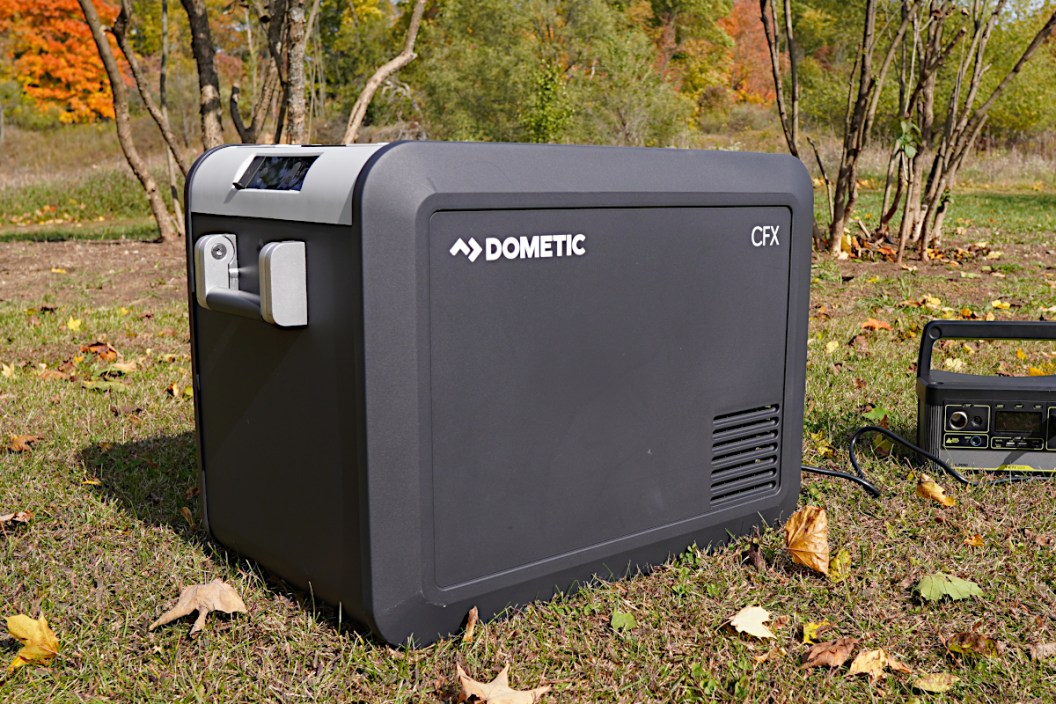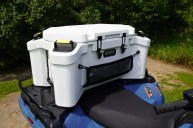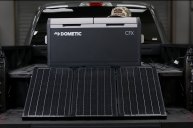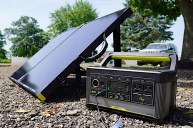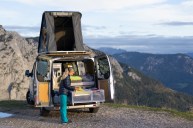We're not sure about you, but we're sick of ice. We're sick of buying it. We're tired of monitoring the ice levels in our cooler and emptying melted ice water from the bottom of the cooler over and over. Finally, we're sick of having food stored in a cooler getting soggy after falling into said ice water. It's plagued campers for decades and is one of the least fun parts of any road trip. So we're glad to finally see technology catching up and giving us a better way of doing things. The Dometic CFX3 electric coolers promise to do just that.
We recently got to do some serious testing of the Dometic CFX3 45. We used it on a road trip and have since tested keeping it running with a bevy of different power sources to see what it could do.
Specs and Features of the Dometic CFX3 45
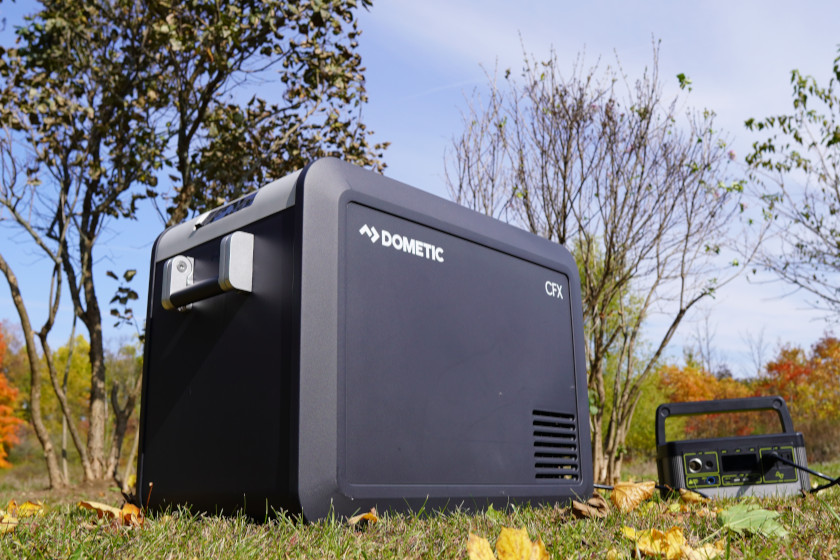
The Dometic CFX3 45 cooler is plugged into a Goal Zero Yeti 500x power station. Photo by Travis Smola
Specs:
- Depth - 27.32 inches
- Width - 15.67 inches
- Height - 18.74 inches
- Weight - 41.23 pounds
- Storage Capacity - 46 liters or 67 cans
- Input Voltage - 120 volts
- Rated Input current - 0.80A at 120V
- Input Voltage - 12 DC and 24 V
- Temperature Range -7° F to +50° F
- Insulation Thickness - 55
- Insulation Type - Polyurethane
- USB port - 5V, 2A
- Interior LED Light
- Bluetooth/WiFi capable
- Anti-condensation Coil
- Drain Plug
- High-resolution Color Display
- Soft Touch Buttons
Many of the specs on the electronics and temperature ranges are identical across the CFX line. The main difference is in the amount of storage space between each model. For our testing, we were utilizing the CFX3 45. This cooler is nearly identical to the popular CFX3 35, with a greater capacity. As you can see, it's a large cooler. The size is comparable to an Igloo BMX 52 that I also own. However, the 41-pound Dometic is much heavier. Much of that weight is likely from the VMSO3 compressor that turns the cooler into a more rugged portable fridge.
Pros and Cons of the Dometic CFX 45
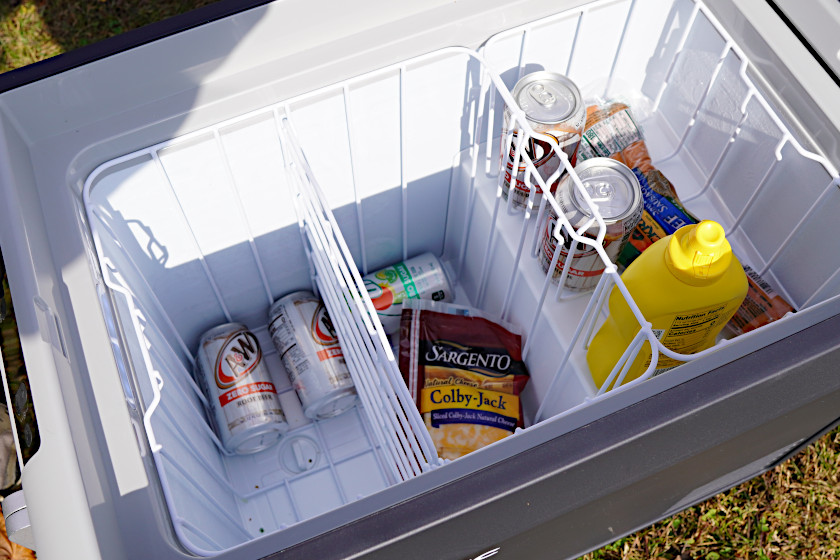
Interior storage compartment of the Dometic CFX3 45 and removable trays. - Photo by Travis Smola
Pros:
- Never buy ice again
- Wide temperature range
- Low Power Consumption
- It can act as an ice maker.
- Rugged and durable
- Easy Functionality
Cons:
- Heavy
- Extra power source needed when off-grid.
- The app could be better.
- Price
We spent several weeks putting the Dometic through its paces, and for the most part, we found more pros than cons with this heavy-duty cooler. For context, we keep meats, cheeses, drinks, and other perishable food items in the cooler for days without losing any freshness. That wide temperature range allows you to keep things frozen, like a portable fridge or freezer. I even used the CFX3 to keep ice cream for extended periods. After turning down the temperature control, I even experimented by freezing ice in a small tray. It's hard to believe, but it works. They're not the most robust cubes you'd get from a freezer, but they'll cool down your drink. And that's not something you can do with your standard cooler!
How Much Power Does a Dometic CFX3 45 Use?
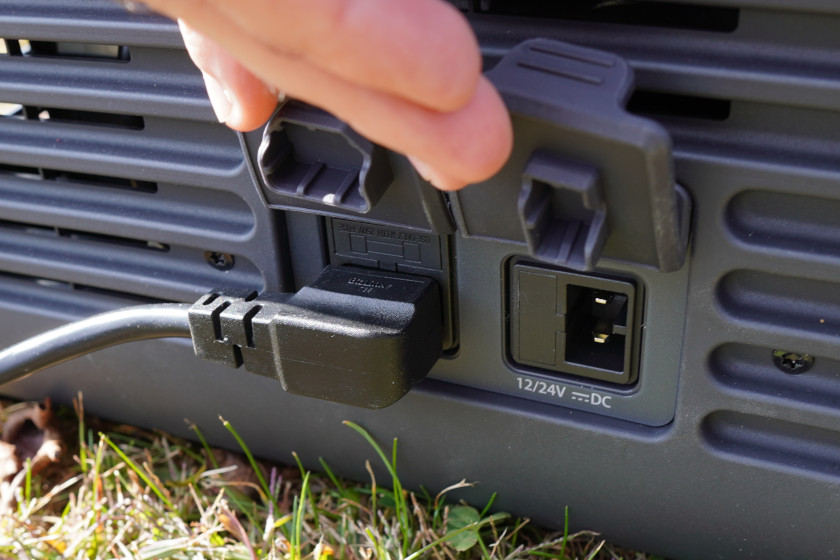
The Dometic CFX3 cooler's 120-volt AC input and 12-volt DC input ports. Photo by Travis Smola
We know this is going to be the primary concern of most users. Honestly, if you're a car camper that stays in modern campsites with full hookups, it's not going to be as much of a worry. Overlanding, boondocking, and off-grid campers will need the extra power. Fortunately, Dometic gives several different options for doing that. This cooler does have a dynamic battery protection system that is supposed to protect against a dead vehicle battery. Dometic says it will also allow deep draw while using dual batteries. The protection system has low, medium, and high protection settings you can switch depending on the device used to power it. Dometic recommends setting it to medium while running the cooler using the DC cable from the car. I kept it low for most of my testing and never once had an issue with the cooler draining the battery in my 2011 Jeep Liberty. I ran the cooler constantly during three to six-hour drives through the DC cable without incident or any damage to my car battery.
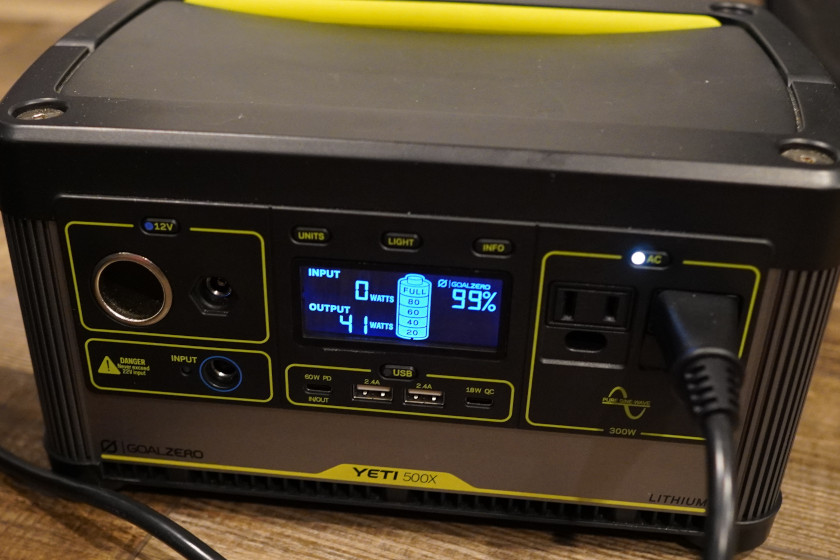
Display on the Goal Zero Yeti 500x power station showing the draw while the compressor is running. I set the temperature to 7° F at the time. Photo by Travis Smola
The portable external power source I used in testing was a Goal Zero Yeti 500x power station. As the name implies, it's a 505-watt-hour unit. It's a colossal lithium battery with AC and DC input and output capabilities. The Yeti also has a handy output digital display, so I could measure exactly how much juice this cooler used while running. My first test of this powered cooler was strict as a refrigeration device. I set the temperature at about 35 to 37 degrees Fahrenheit and let it run all day with only the Yeti 500x as the power source. The Dometic consistently drew seven watts while idle (0.6 amps) and 40 to 60 (about 11.6 amps) when the compressor was running. One thing I noticed is the compressor does not run constantly. It only kicks in to help keep the temperature constant. It might do this once or twice an hour at most, and each time it only ran for roughly 60 seconds before shutting down again. I should note it does this rather quietly too. It's only a low hum. Many nights I slept right next to the cooler while camping, and it never disturbed my slumber once.
In any case, the Dometic will drain the Yeti's 505-watt charge by about 30 to 40 percent over eight hours. I usually still had about 60 to 70 percent of my life remaining at the end of the day. The power station's displays indicated you could expect to get around 30 to 40 hours of charge before the Dometic completely drains it. On that note, I highly recommend not draining a power station like this entirely because it could damage the battery. So, it's a safe bet that you can get 24 to 30 hours before needing to get some more external power into the device. At least with the Yeti 500x power station. Honestly, I would go with a giant power station if I was planning to use this cooler off-grid for longer than a day. I might upgrade my power station to the Yeti 1500x to get a little more run time when off-grid with this thing. You can also significantly extend the run time through an even larger dedicated battery setup.
When I cranked the temperature in the Dometic down to a chilly seven degrees Fahrenheit, energy consumption still sat consistently at around six watts while idle and as high as 55 to 65 watts when the compressor was running. I drained the battery about 40 to 45 percent over about seven hours. The cooler I was testing, the Dometic CFX3 45, can only do fridge or freezer temperatures one at a time. The Dometic CFX3 75 DZ and CFX3 95DZ have a separate dual zone compartment that deep-freezes, so if you need both, those are the options to consider. However, I cannot speak to their power drain.

A power station displays the idle amp draw rate of the Dometic CFX3 cooler. Photo by Travis Smola
Most people will power their Dometic through a battery system that's re-charged via a solar panel. I used the Goal Zero Boulder 100-watt briefcase solar panels for my testing. These panels hook directly into the Yeti. During my testing, I used Goal Zero's 15-foot 8mm extension power cord between the panel and the power station. It matters because there is some loss of power in the transfer between the panel and the power station when using a long cable. You're also rarely going to get the exact wattage of your solar panel, but I was consistently getting 40 to 75 watts of input from the sun while the Dometic was only draining around seven watts. The brief moments when the compressor was running didn't significantly strain the battery. On a bright, sunny day in Northern Michigan, I ran the Dometic and my 17-inch laptop for eight hours while I worked. I did disconnect the computer a few times once the battery was full, but the Dometic stayed plugged in the entire day and used far less power than the computer. I still had a 98 percent charge in the power station.
The power consumption is relatively low when considering what this cooler does. And you can easily offset any power loss with the use of a simple solar panel setup. No wonder many digital nomads and van lifers are using these as portable refrigerators. Even factoring in some energy loss overnight, sunlight blockage, and energy loss via longer cables, I see no reason this setup couldn't keep the Dometic running indefinitely during warmer, sunnier weather.
As a final thought on power use and drain, it's worth noting that there is the Dometic PLB40 portable lithium battery which the company sells specifically to power these coolers. I have not tested this battery myself. However, it's a 40-amp hour (ah) battery, which, as the name suggests, Dometic says, delivers up to 40 hours of cooling from a single charge. At $849, it is expensive, but unless you're using this cooler exclusively while driving in the vehicle, you're probably going to spend money no matter what sort of battery you use to keep this thing powered anyway. It's worthy of consideration as an option, at least.
Construction and Handling
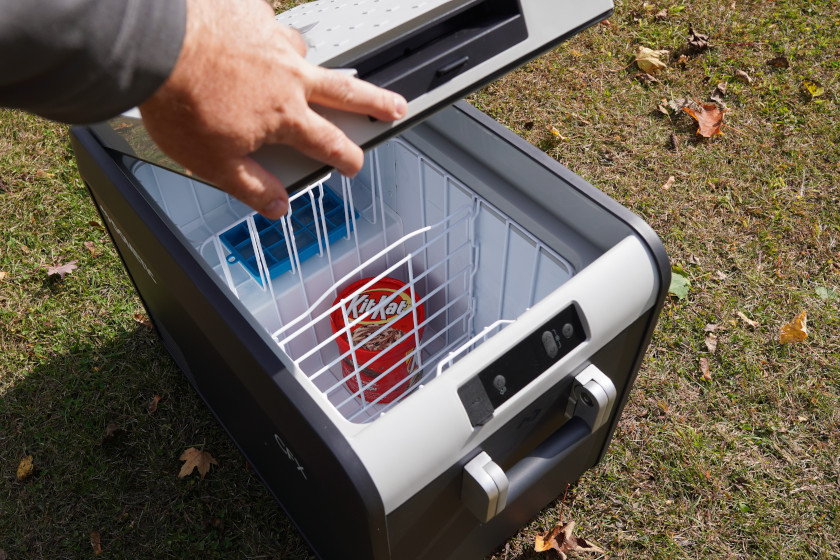
The interior of the CFX3 and interior compartments. Photo by Travis Smola
One immediately obvious thing from when I took the Dometic out of the box was how well they built this cooler. It's a heavy-duty Exoframe construction that can take a real beating. Please make no mistake; I slammed the cooler into a few doors while taking it to and from my vehicle. So far, it has yet to show any signs of this abuse. The company does sell a protective cover if you're worried about scratches. The aluminum alloy handles are probably the most challenging part of this cooler. They're beefy, and some tension to them makes them incredibly ergonomic. It matters when wrestling a 41-pound cooler from your house to your camper or vehicle.
The lid of the cooler opens with a satisfying click. Dometic built a lovely gasket into these coolers that helps seal that cold air inside. Once you open it, a small interior light powers on, just like your fridge at home. It's a simple but welcome feature when you're stumbling around in the dark trying to find your water bottle or a snack before bed. It's one of those features that once you've opened the cooler in the dark a few times, you'll be left wondering how you got along without it.
As far as keeping drinks and food cold, the Dometic does that as well as advertised, and there's not much more I can say about that. However, it is an incredibly freeing feeling to be able to pack meats, cheeses, and other perishables and not have to worry about them going bad because the ice has melted in your cooler. It's nice to pack a cooler to total capacity because half the storage space isn't taken up by ice that you later must dig through to find the item you need. It also helps to keep things organized. One evening I even removed some of the internal dividers so I could store a small leftover pizza box. It fit nicely, and I could enjoy some slices for breakfast the following day. Those dividers will also make it easy to store larger fish filets or a more significant cut of meat while hunting until you can get it to a freezer at home.
Other Features
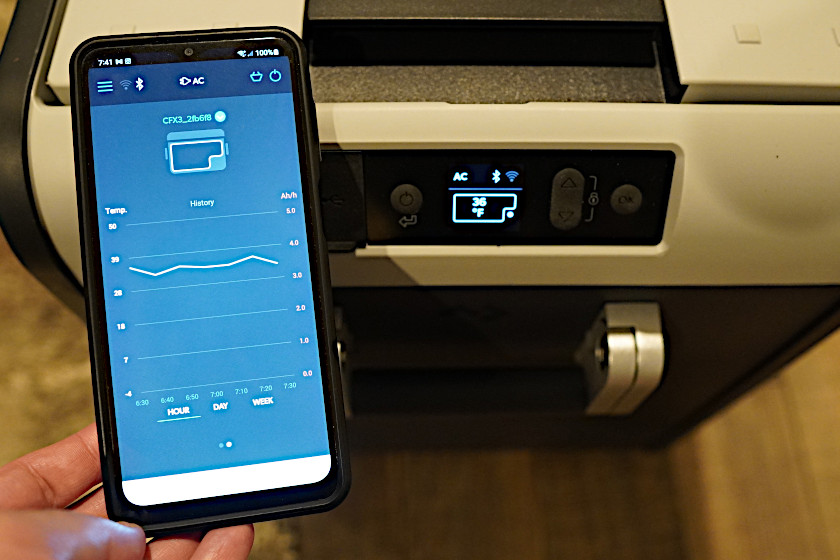
The front display and mobile app show temperature history and power consumption. Photo by Travis Smola
We did want to briefly mention the app that allows you to monitor and operate the cooler via your cell phone. The cooler connects to your device via a WiFi or Bluetooth connection. You can remotely set the temperature from the app, look at the temperature history and power consumption, and even be alerted if the temperature gets too low.
The app's Android version does not have many favorable reviews online. Many users complain about having to pair the two devices constantly. I never had that issue once during my testing. The app did everything as advertised. However, at the same time, I can't say there's not a lot of need for it either. The display and buttons on the front of the cooler are so simple and intuitive that I suspect most people are just going to use those anyway. That's what I ended up doing most of the time. It's a nice little extra, but it doesn't feel like a must-have feature unless you have food or a power setup that needs constant monitoring.
There's a small USB port with a rubber cover on the front that you can plug small electronic devices into charge. I liked this feature. When camping and sleeping in my vehicle, it's nice to have that extra port to keep my phone charged. It's not necessarily something I would have demanded out of this cooler. It's just a pleasant little surprise and adds more functionality to the device, especially if you're planning to use this thing for van life or a road trip with limited space in the vehicle.
The Bottom Line
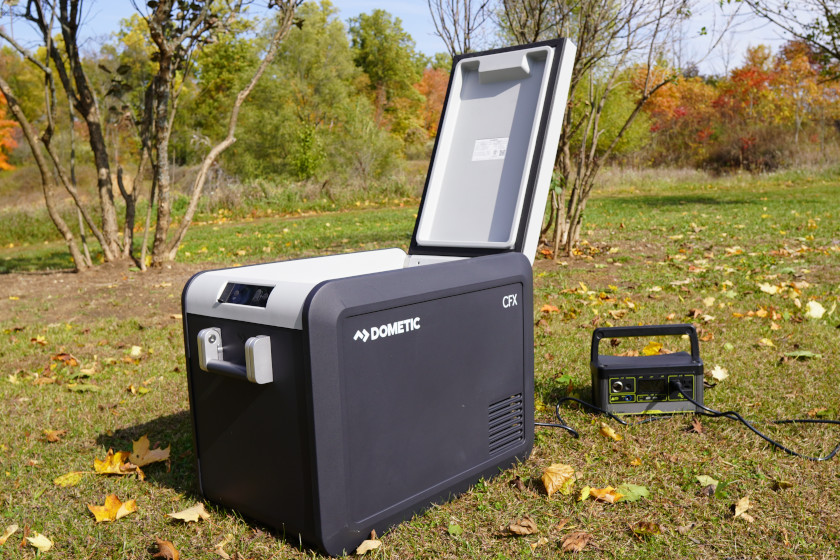
The Dometic CFX3 45 with the lid open. Photo by Travis Smola
Dometic coolers are not cheap, and people are hesitant about the CFX3 45's $1,049.99 MSRP. However, I can safely say these coolers are worth every penny. It may seem a little petty to complain about having to buy ice, but at the same time, it was incredibly freeing to go on a little road trip and never have to worry about that aspect of the freshness of my food and drink. As a result, I could spend more time hiking and exploring than would have been finished looking for the nearest gas station. When you're in a remote area, it's more freeing not to have that extra worry when all you want to do is enjoy your outdoor activities. For road trips, camping, fishing, and hunting, I cannot see myself using any of my old ice coolers ever again. For more information on Dometic's electric-powered cooler offerings, visit their website.
For more outdoor content from Travis Smola, follow him on Twitter and Instagram. Check out his Geocaching and Outdoors with Travis YouTube channels for original videos.
